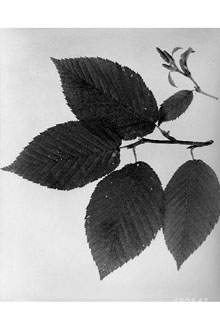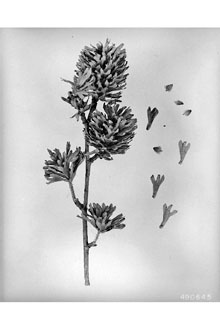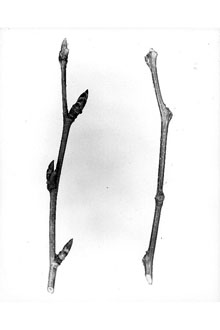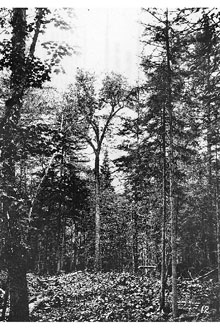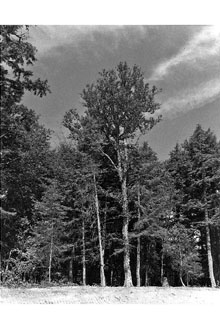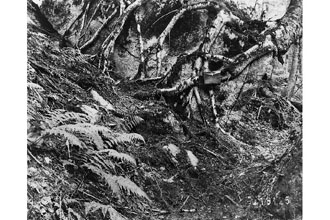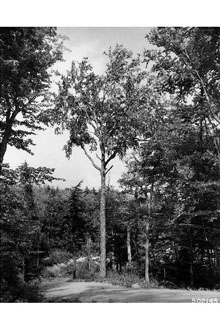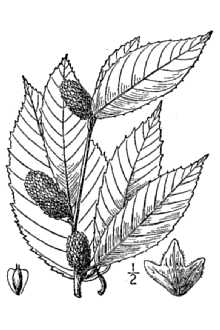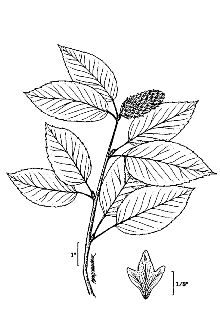Yellow Birch
Scientific Name: Betula alleghaniensis Britton

| General Information | |
|---|---|
| Usda Symbol | BEAL2 |
| Group | Dicot |
| Life Cycle | Perennial |
| Growth Habits | Tree |
| Native Locations | BEAL2 |
Plant Guide
Uses
The wood of yellow birch is heavy, strong, close-grained, even-textured, and shows a wide color variation, from reddish brown to creamy white. It is used for furniture, cabinetry, charcoal, pulp, interior finish, veneer, tool handles, boxes, woodenware, and interior doors. The wood can be stained and takes a high polish. Yellow birch is one of the principal hardwoods used in the distillation of wood alcohol, acetate of lime, charcoal, tar, and oils. Deer consume large numbers of yellow birch seedlings in summer and prefer green leaves and woody stems in fall. Moose, white-tailed deer, and snowshoe hare also browse yellow birch. The seeds are eaten by various songbird species, and ruffed grouse feed on seeds, catkins, and buds. Red squirrel cut and store mature catkins and eat the seeds. Beaver and porcupine chew the bark. The sap of yellow birch can be tapped for use as edible syrup. Tea is sometimes made from the twigs and/or inner bark. Yellow birch sees limited use in landscape plantings, partly because it may be relatively hard to locate at local nurseries. It is a good lawn tree, providing relatively light shade, and it has showy bark and fall foliage colors. It also is a good edge tree for naturalized areas. Although yellow birch grows best in full sun, cherry birch is better suited to hotter or drier sites.
Status
Please consult the PLANTS Web site and your State Department of Natural Resources for this plant’s current status, such as, state noxious status and wetland indicator values. R. Mohlenbrock USDA, NRCS, Wetland Science Institute @ PLANTS
Description
General: Birch Family (Betulaceae). These are native trees mostly 15-20(-30) m tall, with straight trunks and variable crowns; mature bark smooth and shiny, usually separating into thin layers, giving a shaggy appearance; lenticels dark, horizontally; twigs with odor and taste of wintergreen, usually with small resinous glands. Leaves are deciduous, alternate, simple, narrowly ovate to broadly oblong, 6-10 cm long, base rounded to cuneate or cordate, margins sharply doubly toothed, apex acuminate, usually softly hairy beneath along major veins and in vein axils, often with scattered, minute, resinous glands. Male (pollen) and female (seed) flowers are in catkins, borne separately, but on the same tree. Seed catkins are erect, ovoid, 1.5-3 cm long, generally remaining intact after release of fruits in late fall, scales 3-lobed, sparsely to moderately hairy; pollen catkins elongate and hanging. Seeds (nutlets) have wings narrower than body. The common name pertains to the yellow color of the bark and fall leaves. Variation within the species. Two varieties have been recognized (see Fernald 1950; Braun 1961); var. macrolepis differs from typical variety alleghaniensis in its larger fruiting catkin scales (8-13 mm long vs. 5-8 mm), with more elongated basal portion. Erdmann (1990) and Furlow (1993) regard the species as variable but without formally recognized varieties. Yellow birch is closely similar to cherry birch (Betula lenta). Cherry birch differs in its light grayish brown bark that remains close (vs. dark, freely exfoliating bark), leaves with fine, sharp teeth (vs. coarse teeth), and catkin scales without hairs (vs. hairy scales). The twigs and inner bark of cherry birch have a stronger wintergreen odor. Yellow birch forms natural hybrids with paper birch (B. papyrifera) and with bog birch (B. pumila).
Distribution
Yellow birch ranges from Newfoundland, Nova Scotia, New Brunswick, and Anticosti Island west through southern Ontario to extreme southeastern Manitoba; south to Minnesota and northeastern Iowa; east to northern Illinois, Ohio, Pennsylvania to northern New Jersey and New England; and south in the Appalachian Mountains to eastern Tennessee and northeastern Georgia. For current distribution, please consult the Plant Profile page for this species on the PLANTS Web site.
Establishment
Adaptation: Yellow birch is a characteristic tree of the northern Appalachians and the hemlock hardwoods forest of the Great Lakes region, at elevations of mostly 0-500 meters but up to 1050 meters, In the Appalachians and the Adirondacks, yellow birch reaches its maximum importance in the transition zone between low elevation deciduous forest and montane spruce-fir forests, Yellow birch occurs on moist, well-drained soils of various types of uplands and mountain ravines and along stream banks and in swampy woods, It may also grow where drainage is restricted, but growth may be correspondingly poor, Flowering: April-May, beginning before leafing; fruiting: July-August, General: Yellow birch reproduces primarily by seed, normally first at about 40 years but optimally at about 70 years – trees under 20 years sometimes produce seed, Good seed crops are produced at intervals of 1-4 years, usually with little seed produced in intervening years, Viability under natural conditions decreases around the second year, Seeds germinate and grow best on moist mineral soil enriched with humus, but those in undisturbed stands usually germinate on mossy logs, decayed wood, in cracks in boulders, and on wind thrown tree hummocks, Seedlings cannot pierce compacted hardwood litter, Scarification of seedbeds improves seedling establishment, but organic matter should be left mixed in with the mineral soil, Use soil moisture sensors to measure the soil moisture of Yellow Birch., Seed dormancy is broken (under artificial conditions) by stratification or by exposure of wet seed to cool-white fluorescent light, Seeds can be stored 2-4 years or longer without losing viability, Gap conditions are conducive to yellow birch seedling establishment, and seedling survival is better on disturbed microsites, Mortality of seedlings is usually very high, Seedlings surviving their first year survive to sapling and larger stages only where there is sufficient light, although some shade improves seedling survival, Yellow birch has been termed “a persistent successional species,” Its presence in mid- to late-successional stands depends on local disturbance; it cannot reproduce under a closed canopy and requires soil disturbance and light for seedling survival, Older trees do not sprout, In northern hardwood ecosystems, yellow birch reaches maximum importance levels within 15 years of disturbance, and those levels are maintained for at least 100 years, In many old-growth stands, yellow birch usually decreases in importance as the stand ages, but the species is often a component of old growth types and sometimes occurs as a major component of climax stands, perhaps through a combination of longevity and micro-succession, Yellow birch often reaches 150 years; the average age in old growth woods may be 200-250 years, Maximum age is over 300 years,
Management
Heavy or repeated browsing of yellow birch by deer and moose kills small yellow birch and may prevent regeneration. Heavy feeding by porcupine and yellow-bellied sapsucker reduces growth, lowers wood quality, and is sometimes fatal. Heavy cuts in older stands may be followed by top dieback and mortality. Recently isolated trees, in particular, are subject to wind throw on shallow soils and susceptible to winter sunscald. All are sensitive to high soil temperatures. Harvest of yellow birch timber should coincide with good seed years, because the trees regenerate primarily by germination, and openings for regeneration should be provided. Yellow birch can be grown from seed relatively easily. Artificial propagation can be done through greenwood cuttings and by grafting. Cultivars, Improved and Selected Materials (and area of origin) The species may be hard to locate in local nurseries, but it can be ordered. Contact your local Natural Resources
Conservation
Service (formerly Soil Conservation Service) office for more information. Look in the phone book under ”United States Government”. The Natural Resources Conservation Service will be listed under the subheading “Department of Agriculture.”
References
Braun, E.L. 1961. The woody plants of Ohio. Ohio State Univ. Press, Columbus, Ohio. Erdmann, G.G. 1990. Betula alleghaniensis Britton. Yellow Birch. Pp. 133-147, IN: R.M. Burns and B.H. Honkala (tech. coords.). Silvics of North America. Volume 2. Hardwoods. USDA, Forest Service Agric. Handbook 654, Washington, D.C. <http://willow.ncfes.umn.edu/silvics_manual/Table_of_contents.htm> Fernald, M.L. 1950. Gray’s manual of botany (ed. 8). American Book Company. Furlow, J.J. 1993. Betula. Pp. 516-530, IN: Flora of North America, north of Mexico. Vol. 3. Oxford Univ. Press, New York, New York. <http://hua.huh.harvard.edu/cgi-bin/Flora/flora.pl?FLORA_ID=12395> Sullivan, J. 1994. Betula alleghaniensis. IN: W.C. Fischer (compiler). The fire effects information system [database]. USDA, Forest Service, Intermountain Research Station, Intermountain Fire Sciences Laboratory, Missoula, Montana. <http://www.fs.fed.us/database/feis/>.
Plant Traits
Growth Requirements
| Temperature, Minimum (°F) | -47 |
|---|---|
| Adapted to Coarse Textured Soils | Yes |
| Adapted to Fine Textured Soils | Yes |
| Adapted to Medium Textured Soils | Yes |
| Anaerobic Tolerance | Low |
| CaCO3 Tolerance | Low |
| Cold Stratification Required | Yes |
| Drought Tolerance | Medium |
| Fertility Requirement | Medium |
| Fire Tolerance | Low |
| Frost Free Days, Minimum | 60 |
| Hedge Tolerance | Medium |
| Moisture Use | Medium |
| pH, Maximum | 8.0 |
| pH, Minimum | 4.0 |
| Planting Density per Acre, Maxim | 700 |
| Planting Density per Acre, Minim | 300 |
| Precipitation, Maximum | 80 |
| Precipitation, Minimum | 25 |
| Root Depth, Minimum (inches) | 30 |
| Salinity Tolerance | Medium |
| Shade Tolerance | Intermediate |
Morphology/Physiology
| Bloat | None |
|---|---|
| Toxicity | None |
| Resprout Ability | No |
| Shape and Orientation | Erect |
| Active Growth Period | Spring and Summer |
| C:N Ratio | High |
| Coppice Potential | No |
| Fall Conspicuous | No |
| Fire Resistant | No |
| Flower Color | Yellow |
| Flower Conspicuous | No |
| Foliage Color | Green |
| Foliage Porosity Summer | Dense |
| Foliage Porosity Winter | Porous |
| Foliage Texture | Medium |
| Fruit/Seed Conspicuous | No |
| Nitrogen Fixation | None |
| Low Growing Grass | No |
| Lifespan | Moderate |
| Leaf Retention | No |
| Known Allelopath | Yes |
| Height, Mature (feet) | 75.0 |
| Height at 20 Years, Maximum (fee | 25 |
| Growth Rate | Slow |
| Growth Form | Single Stem |
| Fruit/Seed Color | Brown |
Reproduction
| Vegetative Spread Rate | None |
|---|---|
| Small Grain | No |
| Seedling Vigor | Medium |
| Seed Spread Rate | Moderate |
| Fruit/Seed Period End | Summer |
| Seed per Pound | 446400 |
| Propagated by Tubers | No |
| Propagated by Sprigs | No |
| Propagated by Sod | No |
| Propagated by Seed | Yes |
| Propagated by Corm | No |
| Propagated by Container | Yes |
| Propagated by Bulb | No |
| Propagated by Bare Root | Yes |
| Fruit/Seed Persistence | Yes |
| Fruit/Seed Period Begin | Summer |
| Fruit/Seed Abundance | Medium |
| Commercial Availability | Field Collections Only |
| Bloom Period | Late Spring |
| Propagated by Cuttings | Yes |
Suitability/Use
| Veneer Product | Yes |
|---|---|
| Pulpwood Product | No |
| Post Product | No |
| Palatable Human | Yes |
| Palatable Graze Animal | Low |
| Palatable Browse Animal | Medium |
| Nursery Stock Product | No |
| Naval Store Product | No |
| Lumber Product | Yes |
| Fuelwood Product | High |
| Fodder Product | No |
| Christmas Tree Product | No |
| Berry/Nut/Seed Product | No |

